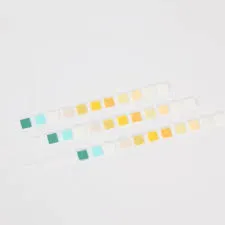May . 15, 2024 16:24 Back to list
10 Parameter Urinalysis Test at Home
10 Parameter Urinalysis Test at Home
What is urinalysis?
A urinalysis is a test of your urine. Urine is produced by the kidneys. The kidneys filter wastes out of the blood, help regulate the amount of water in the body and conserve a balanced level of proteins, electrolytes, and other compounds that the body can reuse. Urine is one of the most valuable biomarkers to assess health. Therefore, by examining the composition of urine, many disorders can be detected.
What is a urinalysis test strip?
A urinalysis strip (dipstick) is a narrow plastic strip with several square-shaped pads of different reagents attached. Each reagent pad represents a chemical parameter (a component of the urine test) used to interpret urinalysis. When dipped in the urine, the colors of the pads change in response to the chemical characteristics of the urine. The dipstick urinalysis test is very commonly used by physicians as an aid diagnosis of diseases and to monitor health.
A urinalysis strip can help in the general monitoring of health as well as in the detection of a broad spectrum of abnormalities.
How can at-home urine testing help?
A home-use urinalysis strip can enable you to monitor your health from the convenience of your home. Going to a medical professional for a urine test every time you think you have some issue can be time-consuming, expensive, and frustrating. At-home screening provides convenience and helps you stay proactive with regular and frequent urine screening, so you can get timely care when needed.
Urinalysis can assist in the diagnosis and monitoring of many metabolic or systemic diseases that can go unnoticed because they haven't produced striking signs or symptoms yet.
14 Parameter Urine Urinalysis Test Strip
10 parameters of a urinalysis strip
A 10-parameter urine test strip such as Urinox-10 by Diagnox tests ten different urine parameters that include:
- Leukocytes (for possible inflammation)
- Nitrites (for bacteria in urine)
- Urobilinogen (for liver health)
- Protein (for kidney and urinary tract health)
- pH (for acidity and alkalinity of the urine sample)
- Blood (for visible and non-visible blood in urine)
- Specific Gravity (for hydration status and the body's ability to conserve water)
- Ketones (for diabetes and high-fat/low-carb diets)
- Bilirubin (for liver health)
- Glucose (for diabetes)
Urinalysis can assist in the diagnosis and monitoring of many metabolic and systemic diseases that can go unnoticed because they haven’t produced striking signs or symptoms yet.
How to conduct a urinalysis test?
You can easily conduct a urinalysis test with a urine dipstick at home or in professional settings by following these steps:
1. Immerse
Immerse the strip into the urine sample and remove it immediately by dragging the edge of the strip against the container rim to remove excess urine. If reading the strip visually, start timing.
It is essential that you always use a fresh urine specimen in a clean, dry container.
2. Wait
Place the strip horizontally on a paper towel or tissue to remove excess and wait until the results are ready to be read. The reading time for different tests is provided on the product packaging or package insert.
3. Compare
Compare each test pad to the corresponding row of the color chart on the package insert (or packaging) to find the closest match (see an example color chart below). It is essential to read the results carefully in a good light. Usually, changes in color that appear after 2 minutes are of no diagnostic significance – therefore, try to read results as soon as they are ready.
Urine test results color chart
The urinalysis color chart is a grid of colors that serve as a key for interpreting the results. Each row of color blocks represents possible color outcomes for each parameter. For a 10-parameter strip, you will find ten rows of color blocks, each representing possible color outcomes for the respective reagent/parameter.
It is advisable to use the color chart provided by the manufacturer to compare the colors of the reagent pads to interpret the results. A printed color chart (provided by the manufacturer) is calibrated and will offer better reliability. Colors may appear differently on a digital copy (e.g., from a screen image).

Reading times
The reading time refers to the time at which the color of the pad should be compared with the color key. The reading time varies for each parameter, ranging from 30 seconds (for the glucose pad) to 120 seconds (for the Leukocyte pad).
The reagent pads are ordered sequentially to help with visual reading at the correct times. The glucose pad is typically the lower-most pad, whereas the leukocyte pad is the top-most pad. When reading a dipstick, you read from the bottom pad (ready in 30 seconds) to the top pad (ready in 120 seconds).
Using a stopwatch can help you know the precise time when each test is ready for color comparison.
The reading times for the ten urinalysis parameters are given below:
- Leukocytes: 2 minutes
- Nitrites: 1 minute
- Urobilinogen: 1 minute
- Protein: 1 minute
- pH: 1 minute
- Blood: 1 minute
- Specific Gravity: 45 seconds
- Ketones: 40 seconds
- Bilirubin: 30 seconds
- Glucose: 30 seconds
-
Reliable Early Pregnancy Test Kit Supplier - Multi Plastic Cassette Options
NewsJul.30,2025
-
Transferrin Rapid Test Cassette – Reliable Tumor Marker Detection
NewsJul.29,2025
-
Accurate Follicle Stimulating Hormone Test Kit | Rapid Reliable Results
NewsJul.29,2025
-
High Accuracy LH Ovulation Test Kit - Digital Results & Wholesale Options
NewsJul.29,2025
-
HbsAg Blood Rapid Test Kit for Fast & Accurate Hepatitis B Detection
NewsJul.28,2025
-
Sterile Urine Cup for Safe & Easy Collection | High-Quality Specimen Cups
NewsJul.28,2025


